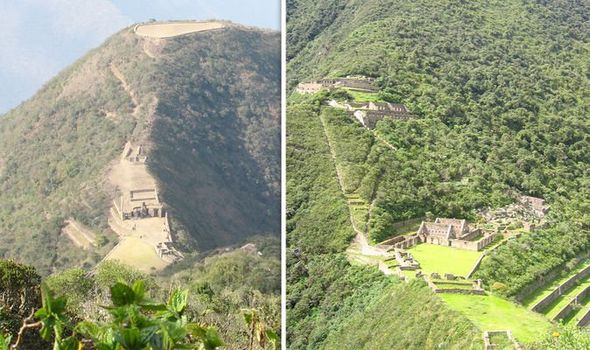How ‘secret Inca city’ was found hiding below Amazon jungle rising ‘lost treasure’ hopes
Some scholars consider the Incas to be the most powerful in the Americas, occupying the Peruvian mountains until 1572, when the Spaniards captured the last fortress.
Proof of this advanced civilization is still visible today, with Machu Picchu, the most famous tourist destination, becoming the most popular. The least known settlement of Choquequirao is hidden, however, in the shadows of this fortification of the 15th century, which is located 2430 meters above sea level.
Reachable only from a two-day hike from Cusco, this city was one of the last bastions of resistance and spans more than 18,000 square meters into the deep undergrowth of the Amazon jungle.
Only around 30 percent of Choquequirao has been excavated and Amazon Prime’s “Mysterious World of the Inca” revealed why this location was key.
The narrator said in 2009: “All across the former empire of the Incas we find numerous strange and mysterious places called Huaca, these were a kind of idol, which according to the Indians, had supernatural powers.
“In addition to artificially created shrines, a Huaca could be practically anything, such as strangely shaped stones, mountains or lakes.


“Many remained hidden from the Spanish like Choquequirao, another gem of Inca architecture escaped destruction at the hands of the conquerors. “This is thanks to its inaccessibility, as it hides in the shadows of the famous Machu Picchu.
“It is likely that its significance was more practical than spiritual, on nearby slopes they grew cocoa, an ideal plant for the local climate.” The series went on to reveal how this settlement was first uncovered. The narrator added: “After the death of the last Inca, at the end of the 16th century, Choquequirao fell into oblivion.

“The first Europeans arrived in this place only in the mid 19th century and the city, which means Cradle of Gold, was rediscovered by Hiram Bingham.
“The character of the buildings, with typical trapezoidal windows and embrasure spaces, where residents placed their daily articles, is important, including the ingenious system of canals and precise orientation of the elegant buildings.
“It was not noticed and thanks to the luxurious vegetation and nearly impassable terrain of the East Andes, the last ruler – Tupac Amaru – was able to rule over the last Inca territory not conquered by the Spanish.”
However, the series went on to reveal how evidence of the last civilization may still remain below the undergrowth.


It continued: “Defended by several wild valleys and his trusted followers, he went to the very edge of the Amazon forest, forming the last secret city of the Incas.
“After wading through the river, the Spanish force finally reached it thanks to information from a betrayer.
“But perhaps the ruins of the palaces of the last Inca hide unknown secrets and they main contain part of the still undiscovered treasure of the Incas.
“Somewhere the jungle is covering the last sanctuary of the great Inca sun god, but it will be many years before more is revealed.”
Machu Picchu is both a cultural and natural UNESCO World Heritage Site, and since its discovery, a growing number of tourists have visited the site. Now it is one of Peru’s most visited tourist attraction and major revenue generator, it is continually exposed to economic and commercial forces.
In the late Nineties, the Peruvian government granted concessions to allow the construction of a cable car and a luxury hotel, including a tourist complex with boutiques and restaurants and a bridge to the site. Many people protested the plans, saying that more visitors would pose a physical burden on the ruins.





